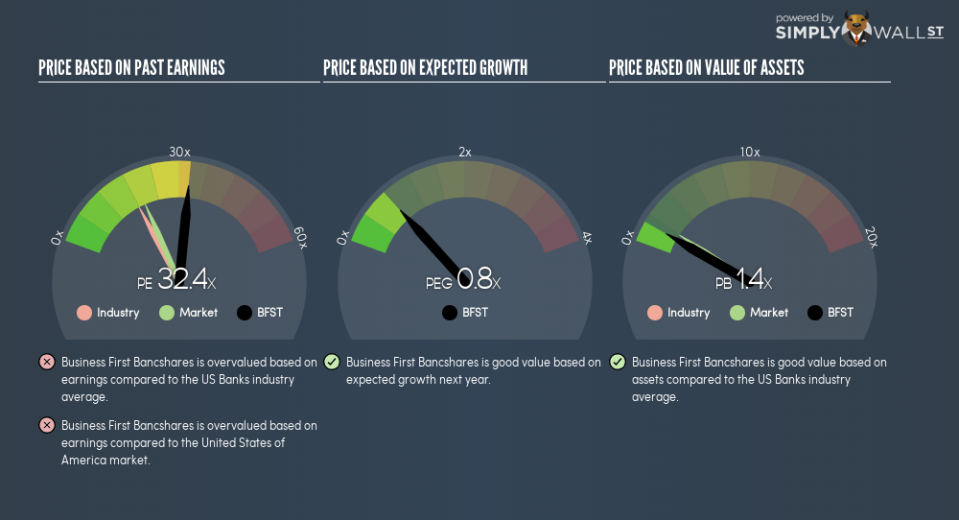Is Business First Bancshares Inc (NASDAQ:BFST) Attractive At Its Current PE Ratio?

I am writing today to help inform people who are new to the stock market and want to begin learning about how to value company based on its current earnings and what are the drawbacks of this method.
Business First Bancshares Inc (NASDAQ:BFST) is trading with a trailing P/E of 32.4, which is higher than the industry average of 17.9. While this might not seem positive, it is important to understand the assumptions behind the P/E ratio before you make any investment decisions. Today, I will break down what the P/E ratio is, how to interpret it and what to watch out for.
See our latest analysis for Business First Bancshares
Breaking down the Price-Earnings ratio
The P/E ratio is a popular ratio used in relative valuation since earnings power is a key driver of investment value. It compares a stock’s price per share to the stock’s earnings per share. A more intuitive way of understanding the P/E ratio is to think of it as how much investors are paying for each dollar of the company’s earnings.
P/E Calculation for BFST
Price-Earnings Ratio = Price per share ÷ Earnings per share
BFST Price-Earnings Ratio = $26.04 ÷ $0.804 = 32.4x
The P/E ratio itself doesn’t tell you a lot; however, it becomes very insightful when you compare it with other similar companies. We want to compare the stock’s P/E ratio to the average of companies that have similar characteristics as BFST, such as size and country of operation. One way of gathering a peer group is to use firms in the same industry, which is what I’ll do. At 32.4, BFST’s P/E is higher than its industry peers (17.9). This implies that investors are overvaluing each dollar of BFST’s earnings. This multiple is a median of profitable companies of 25 Banks companies in US including Great Basin Financial, Mercantil Servicios Financieros C.A and CIB Marine Bancshares. You could think of it like this: the market is pricing BFST as if it is a stronger company than the average of its industry group.
Assumptions to be aware of
However, it is important to note that our examination of the stock is based on certain assumptions. Firstly, that our peer group contains companies that are similar to BFST. If this isn’t the case, the difference in P/E could be due to other factors. For example, if Business First Bancshares Inc is growing faster than its peers, then it would deserve a higher P/E ratio. Of course, it is possible that the stocks we are comparing with BFST are not fairly valued. Thus while we might conclude that it is richly valued relative to its peers, that could be explained by the peer group being undervalued.
What this means for you:
You may have already conducted fundamental analysis on the stock as a shareholder, so its current overvaluation could signal a potential selling opportunity to reduce your exposure to BFST. Now that you understand the ins and outs of the PE metric, you should know to bear in mind its limitations before you make an investment decision. Remember that basing your investment decision off one metric alone is certainly not sufficient. There are many things I have not taken into account in this article and the PE ratio is very one-dimensional. If you have not done so already, I urge you to complete your research by taking a look at the following:
Future Outlook: What are well-informed industry analysts predicting for BFST’s future growth? Take a look at our free research report of analyst consensus for BFST’s outlook.
Past Track Record: Has BFST been consistently performing well irrespective of the ups and downs in the market? Go into more detail in the past performance analysis and take a look at the free visual representations of BFST’s historicals for more clarity.
Other High-Performing Stocks: Are there other stocks that provide better prospects with proven track records? Explore our free list of these great stocks here.
To help readers see past the short term volatility of the financial market, we aim to bring you a long-term focused research analysis purely driven by fundamental data. Note that our analysis does not factor in the latest price-sensitive company announcements.
The author is an independent contributor and at the time of publication had no position in the stocks mentioned. For errors that warrant correction please contact the editor at editorial-team@simplywallst.com.

